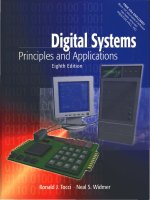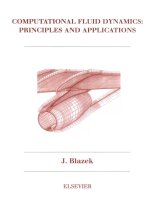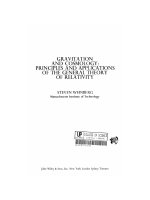acharya, ray - image processing. principles and applications 2005
Bạn đang xem bản rút gọn của tài liệu. Xem và tải ngay bản đầy đủ của tài liệu tại đây (31.74 MB, 451 trang )
Image
Processing
Principles and Applications
Tinku
Acharya
Avisere, Inc.
Tucson, Arizona
and
Department
of
Electrical Engineering
Arizona State University
Tempe, Arizona
Ajoy
K.
Ray
Avisere, Inc.
Tucson, Arizona
and
Electronics and Electrical Communication Engineering Department
Indian Institute
of
Technology
Kharagpur, India
@ZEiCIENCE
A
JOHN
WILEY
&
SONS,
MC., PUBLICATION
Processing
This Page Intentionally Left Blank
Image
Processing
Principles and Applications
Tinku
Acharya
Avisere, Inc.
Tucson, Arizona
and
Department
of
Electrical Engineering
Arizona State University
Tempe, Arizona
Ajoy
K.
Ray
Avisere, Inc.
Tucson, Arizona
and
Electronics and Electrical Communication Engineering Department
Indian Institute
of
Technology
Kharagpur, India
@ZEiCIENCE
A
JOHN
WILEY
&
SONS,
MC., PUBLICATION
Copyright
0
2005 by
John
Wiley
&
Sons, Inc. All rights reserved.
Published by John Wiley
&
Sons, Inc., Hoboken, New Jersey.
Published simultaneously in Canada.
No
part of this publication may be reproduced, stored in a retrieval system,
or
transmitted in any form
or
by any means, electronic, mechanical, photocopying, recording, scanning,
or
otherwise, except as
permitted under Section 107
or
108 of the 1976 United States Copyright Act, without either the prior
written permission of the Publisher, or authorization through payment of the appropriate per-copy fee to
the Copyright Clearance Center, Inc., 222 Rosewood Drive, Danvers, MA 01923, (978) 750-8400, fax
(978) 750-4470, or on the web at www.copyright.com. Requests to the Publisher for permission should
be addressed to the Permissions Department, John Wiley
&
Sons, lnc., 11 1 River Street, Hoboken, NJ
07030, (201) 748-601 1, fax (201) 748-6008,
or
online at
Limit
of
Liability/Disclaimer of Warranty: While the publisher and author have used their best efforts in
preparing this book, they make no representations
or
warranties with respect
to
the accuracy
or
completeness of the contents
of
this book and specifically disclaim any implied warranties of
merchantability
or
fitness
for a particular purpose. No warranty may be created
or
extended by sales
representatives
or
written sales materials. The advice and strategies contained herein may not be
suitable for your situation.
You
should consult with a professional where appropriate. Neither the
publisher nor author shall be liable for any
loss
of profit or any other commercial damages, including
but not limited to special, incidental, consequential,
or
other damages.
For general information on
our
other products and services
or
for technical support, please contact our
Customer Care Department within the United States at (800) 762-2974, outside
the
United States at
(317) 572-3993
or
fax (317) 572-4002.
Wiley also publishes its books in a variety of electronic formats. Some content that appears in print may
not be available in electronic format. For information about Wiley products, visit
our
web site at
www.wiley.com.
Librury
of
Congress
Cataloging-in-Publicution
Dutu:
Acharya, Tinku.
Image processing
:
principles and applications
/
Tinku Acharya, Ajoy
K.
Ray.
“A Wiley-Interscience Publication.”
Includes bibliographical references and index.
ISBN-13 978-0-471-71998-4 (cloth
:
alk. paper)
ISBN-10 0-471-71998-6 (cloth
:
alk. paper)
TA1637.A3 2005
621.36‘74~22 2005005170
p. cm.
1. Image processing.
I.
Ray, Ajoy
K.,
1954-
11.
Title.
Printed in the United States of America
I0987654321
In memory of
my
father, Prohlad
C.
Acharya
-Tinku
In memories of
my
mother, father, and uncle
-Ajoy
This Page Intentionally Left Blank
Contents
Preface
1
Introduction
1.1
1.2
1.3
1.4
1.5
1.6
1.7
Fundamentals of Image Processing
Applications of Image Processing
1.2.1
Automatic Visual Inspection System
1.2.2
Remotely Sensed Scene Interpretation
1.2.3
Biomedical Imaging Techniques
1.2.4
Defense surveillance
1.2.5
Content-Based Image Retrieval
1.2.6
Moving-Object Tracking
1.2.7
Image and Video Compression
Human Visual Perception
1.3.1
Human Eyes
1.3.2
Components
of
an Image Processing System
1.4.1
Digital Camera
Organization of the book
How is this book different?
Summary
Neural Aspects
of
the Visual Sense
xix
1
1
3
3
4
4
5
6
6
7
7
8
9
9
10
12
14
15
Vii
viii
CONTENTS
References
2
Image Formation and Representation
2.1
2.2
2.3
2.4
2.5
2.6
2.7
2.8
Introduction
Image formation
2.2.1
Illumination
2.2.2
Reflectance Models
2.2.3
Point Spread Function
Sampling and Quantization
2.3.1
Image Sampling
2.3.2
Image Quantization
Binary Image
2.4.1
Geometric Properties
2.4.2
Three-Dimensional Imaging
2.5.1
Stereo Images
2.5.2
Range Image Aquisition
Image file formats
Some Important Notes
Summary
References
Chain code representation of a binary object
3
Color and Color Imagery
3.1
Introduction
3.2
Perception
of
Colors
3.3
3.4
Color Space and Transformation
Color Space Quantization and Just Noticeable Difference
(JND)
3.4.1
ChlYK
space
3.4.2
NTSC or
YIQ
Color Space
3.4.3
YCbCr
Color Space
3.4.4
Perceptually Uniform Color Space
3.4.5
CIELAB color Space
3.5.1
Sonadaptive Color Interpolation Algorithms
3.5.2
Adaptive algorithms
3.5.3
3.5.4
Experimental Results
3.5
Color Interpolation
or
Demosaicing
A Novel Adaptive Color Interpolation Algorithm
3.6
Summary
15
17
17
17
17
19
20
22
23
25
26
27
29
31
31
32
33
34
35
36
37
37
38
39
40
40
41
41
41
44
45
46
48
53
57
59
CONTENTS
ix
References
59
4
Image Transformation
4.1
Introduction
4.2
Fourier Transforms
4.2.1
One-Dimensional Fourier Transform
4.2.2
Two-Dimensional Fourier Transform
4.2.3
Discrete Fourier Transform (DFT)
4.2.4
Transformation Kernels
4.2.5
Matrix Form Representation
4.2.6
Properties
4.2.7
Fast
Fourier Transform
4.3
Discrete Cosine Transform
4.4
Walsh-Hadamard Transform (WHT)
4.5
Karhaunen-Loeve Transform or Principal Component Analysis
4.5.1
Covariance Matrix
4.5.2
Eigenvectors and Eigenvalues
4.5.3
Principal Component Analysis
4.5.4
Singular Value Decomposition
References
4.6
Summary
5
Discrete Wavelet Transform
5.1
Introduction
5.2
Wavelet Transforms
5.2.1
Discrete Wavelet Transforms
5.2.2
Gabor filtering
5.2.3
Concept of Multiresolution Analysis
5.2.4
Implementation by Filters and the Pyramid Algorithm
5.3
Extension to Two-Dimensional Signals
5.4
Lifting Implementation of the DWT
5.4.1
5.4.2
5.4.3
5.4.4
Lifting
5.4.5
Finite Impulse Response Filter and Z-transform
Euclidean Algorithm for Laurent Polynomials
Perfect Reconstruction and Polyphase Representation
of Filters
Data Dependency Diagram for Lifting Computation
5.5
Advantages of Lifting-Based DWT
5.6
Summary
61
61
62
62
63
64
64
65
67
68
70
72
73
75
75
76
76
78
78
79
79
80
82
83
85
87
89
90
92
93
94
96
102
103
103
x
CONTENTS
References
6
Image Enhancement and Restoration
6.1
Introduction
6.2
6.3
Spatial Image Enhancement Techniques
Distinction between image enhancement and restoration
6.3.1
Spatial Low-Pass and High-Pass Filtering
6.3.2
Averaging and Spatial Low-Pass Filtering
6.3.3
Unsharp Masking and Crisping
6.3.4
Directional Smoothing
6.4.1
Image Histogram
6.4.2
Histogram Equalization
6.4.3
Local Area Histogram Equalization
6.4.4
Histogram Specificat ion
6.4.5
Histogram Hyperbolization
6.4.6
Median Filtering
Frequency Domain Methods of Image Enhancement
6.5.1
Homomorphic Filter
6.6.1
6.4
Histrogram-based Contrast Enhancement
6.5
6.6
Noise Modeling
6.7
Image Restoration
Types
of
Noise in
An
Image and Their Characteristics
Image Restoration of Impulse Noise Embedded Images
6.7.1
6.7.2
Restoration of Blurred Image
6.7.3
Inverse Filtering
6.7.4
Wiener Filter
Image Reconstruction by Other Methods
6.8.1
Image Restoration by Bispectrum
6.8.2
Tomographic Reconstruct ion
References
6.8
6.9
Summary
7
Image Segmentation
7.1
Preliminaries
7.2
7.3
Edge Detector
Edge, Line, and Point Detection
7.3.1
Robert Operator-Based Edge Detector
104
105
105
106
107
107
108
109
109
110
110
111
113
113
114
114
115
117
118
120
121
122
123
123
124
127
127
128
128
128
131
131
132
135
135
7.3.2
Sobel Operator-Based Edge Detector
135
CONTENTS
xi
7.3.3
Prewitt Operator-Based Edge Detector
7.3.4
Kirsch Operator
7.3.5
Canny’s Edge Detector
7.3.6
Operators-Based on Second Derivative
7.3.7
Limitations of Edge-Based Segmentation
7.4.1
Bi-level Thresholding
7.4.2
Multilevel Thresholding
7.4.3
Entropy-Based Thresholding
7.4.4
7.4
Image Thresholding Techniques
Problems Encountered and Possible Solutions
7.5
Region Growing
7.5.1
Region Adjacency Graph
7.5.2
Region Merging and Splitting
7.5.3
Clustering Based Segmentation
7.6
Waterfall algorithm for segmentation
7.7
Connected component labeling
7.8
Document Image segmentation
7.9
Summary
References
8
Recognition of Image Patterns
8.1
Introduction
8.2
Decision Theoretic Pattern Classification
8.3
Bayesian Decision Theory
8.3.1
Parameter Estimation
8.3.2
Minimum Distance Classification
8.4
Nonparametric Classification
8.5
Linear Discriminant Analysis
8.6
8.4.1
K-Nearest-Neighbor Classification
Unsupervised Classification Strategies
-
clustering
8.6.1
Single Linkage Clustering
8.6.2
Complete Linkage Clustering
8.6.3
Average Linkage Clustering
8.7
K-Means Clustering Algorithm
8.8
Syntactic Pattern Classification
8.8.1
Primitive selection Strategies
8.8.2
High-Dimensional Pattern Grammars
8.9
Syntactic Inference
136
136
137
140
143
143
144
145
146
147
148
148
149
150
151
152
152
154
155
157
157
158
159
160
160
162
162
163
164
165
166
166
166
167
168
169
169
8.10
Symbolic Projection Method
8.11
Artificial Neural Networks
8.11.1
Evolution of Neural Networks
8.11.2
Multilayer Perceptron
8.11.3
Kohonen’s Self-organizing Feature Map
8.11.4
Counterpropagation Neural Network
8.11.5
Global Features
of
Networks
8.12
Summary
References
9
Texture and Shape Analysis
9.1
9.2
9.3
9.4
9.5
9.6
9.7
9.8
9.9
Introduction
9.1.1
Primitives in Textures
9.1.2
Classification of textures
Gray Level Cooccurrence Matrix
9.2.1
Spatial Relationship
of
Primitives
9.2.2
Generalized Cooccurrence
Texture Spectrum
Texture Classification using Fractals
9.4.1
Fractal Lines and Shapes
9.4.2
Fractals in Texture Classification
9.4.3
Shape Analysis
9.5.1
Landmark Points
9.5.2
Polygon as Shape Descriptor
9.5.3
9.5.4
9.5.5
Active Contour Model
9.6.1
Deformable Template
Shape Distortion and Normalization
9.7.1
Shape Dispersion Matrix
9.7.2
9.7.3
Contour-Based Shape Descriptor
9.8.1
Fourier based shape descriptor
Region Based Shape Descriptors
9.9.1
Zernike moments
Computing Fractal Diniension Using Covering Blanket
method
Dominant points in Shape Description
Curvature and Its Role in Shape Determination
Polygonal Approximation for Shape Analysis
Shifting and Rotating the Coordinate Axes
Changing the scales of the bases
170
171
172
172
175
176
178
178
179
181
181
182
182
183
185
186
186
187
188
189
189
191
192
192
193
193
194
194
196
198
198
199
200
201
20
1
203
203
CONTENTS
xi;;
9.9.2
Radial Chebyshev Moments (RCM)
9.10
Gestalt Theory of Perception
9.11
Summary
References
10
Fuzzy Set Theory in Image Processing
10.1
Introduction to Fuzzy Set Theory
10.2
Why Fuzzy Image?
10.3
Introduction to Fuzzy Set Theory
10.4
Preliminaries and Background
10.4.1
Fuzzification
10.4.2
Basic Terms and Operations
10.5
Image
as
a
Fuzzy Set
10.5.1
Selection of the Membership Function
10.6
Fuzzy Methods of Contrast Enhancement
10.6.1
Contrast Enhancement Using Fuzzifier
10.6.2
Fuzzy Spatial Filter for Noise Removal
10.6.3
Smoothing Algorithm
10.7
Image Segmentation using Fuzzy Methods
10.8
Fuzzy Approaches to Pixel Classification
10.9
Fuzzy c-Means Algorithm
10.10
Fusion of fuzzy logic with neural networks
10.10.1
Fuzzy Self Organising Feature Map
10.11
Summary
References
11
Image Mining and Content-Based Image Retrieval
11.1
Introduction
11.2
Image Mining
11.3
Image Features
for
Retrieval and Mining
11.3.1
Color Features
11.3.2
Texture Features
11.3.3
Shape features
11.3.4
Topology
11.3.5
Multidimensional Indexing
11.3.6
Results of
a
Simple CBIR System
204
204
204
205
209
209
209
210
211
211
212
213
214
215
216
217
218
219
221
221
223
224
225
225
227
227
228
231
231
234
235
237
239
241
11.4
Fuzzy Similarity Measure in an Image Retrieval System
242
11.5
Video Mining
245
xiv
CONTENTS
11.5.1
MPEG7: Multimedia Content Description Interface
11.5.2
Content-Based Video Retrieval System
References
11.6
Summary
12
Biometric And Biomedical Image Processing
12.1
Introduction
12.2
Biometric Pattern Recognition
12.2.1
Feature Selection
12.2.2
Extraction of Front Facial Features
12.2.3
Extraction of side facial features
12.2.4
Face Identification
12.3
Face Recognition Using Eigenfaces
12.4
Signature Verification
12.5
Preprocessing of Signature Patterns
12.6
Biomedical Image Analysis
12.3.1
Face Recognition Using Fisherfaces
12.5.1
Feature Extraction
12.6.1
Microscopic Image Analysis
12.6.2
Macroscopic Image Analysis
12.7.1
Magnetic Resonance Imaging (MRI)
12.7.2
Computed Axial Tomography
12.7.3
Nuclear and Ultrasound Imaging
12.8.1
X-Ray Images for Lung Disease Identification
12.8.2
Enhancement
of
Chest X-Ray
12.8.3
CT-scan for Lung Nodule Detection
12.8.4
X-Ray Images for Heart Disease Identification
12.8.5
X-Ray Images for Congenital Heart Disease
12.8.6
Enhancement of Chest Radiographs Using Gradient
Operators
12.8.7
Bone Disease Identification
12.8.8
Rib-cage Identification
12.9
Dental X-Ray Image Analysis
12.10
Classification of Dental Caries
12.11
Mammogram Image Analysis
12.11.1
Breast Ultrasound
12.7
Biomedical Imaging Modalities
12.8
X-Ray Imaging
12.10.1
Classification of Dental Caries
246
248
249
250
253
253
254
254
254
256
257
257
258
259
260
262
263
263
264
264
264
265
266
267
267
267
268
268
269
2 70
271
271
272
272
273
2 74
2 75
CONTENTS
xv
12.11.2
Steps in Mammogram Image Analysis
12.11.3
Enhancement
of
Mammograms
12.11.4
Suspicious Area Detection
12.11.5
LESION SEGMENTATION
12.11.6
Feature Selection and Extraction
12.11.7
Wavelet Analysis
of
Mammogram Image
References
12.12
Summary
13
Remotely Sensed Multispectral Scene Analysis
13.1
Introduction
13.2
Satellite sensors and imageries
13.2.1
LANDSAT Satellite Images
13.2.2
Indian Remote Sensing Satellite Imageries
13.2.3
Moderate Resolution Imaging Spectroradiometer
(MODIS)
13.2.4
Synthetic Aperture Radar (SAR)
13.3.1
Data Formats
for
Digital Satellite Imagery
13.3.2
Distortions and Corrections
13.4
Spectral reflectance
of
various earth objects
13.4.1
Water Re,' wions
13.4.2
Vegetation Regions
13.4.3
Soil
13.4.4
Man-made/Artificial Objects
13.5.1
Neural Network-Based Classifier Using Error
Backpropagation
13.5.2
Counterpropagation network
13.5.3
Experiments and Results
13.5.4
Classification Accuracy
13.6.1
Spectral Information
of
Natural/Man-Made Objects
13.6.2
Training Site Selection and Feature Extraction
13.6.3
System Implement
at
ion
13.6.4
Rule Creation
13.6.5
Rule-Base Development
13.7.1
Evidence Accumulation
13.3
Features of Multispectral Images
13.5
Scene Classification Strategies
13.6
Spectral classification-A knowledge-Based Approach
13.7
Spatial Reasoning
2
75
275
276
277
2
79
280
281
282
285
285
286
286
287
287
288
289
289
289
291
291
291
292
292
293
293
294
294
295
296
297
297
297
298
299
300
301
xvi
CONTENTS
13.7.2
Spatial Rule Generation
13.8
Other Applications of Remote Sensing
13.8.1
Change Detection using SAR Imageries
13.9
Summary
References
14
Dynamic Scene Analysis: Moving Object Detection and Tracking
14.1
Introduction
14.2
Problem Definition
14.3
Adaptive Background Modeling
14.3.1
Basic Background Modeling Strategy
14.3.2
A
Robust Method
of
Background Modeling
14.4
Connected Component Labeling
14.5
Shadow Detection
14.6
Principles of Object Tracking
14.7
Model
of
Tracker System
14.8
Discrete Kalman Filtering
14.9
Extended Kalman Filtering
14.10
Particle Filter Based object Tracking
14.10.1
Particle Attributes
14.10.2
Particle Filter Algorithm
14.10.3
Results of Object Tracking
14.8.1
Discrete Kalman Filter Algorithm
14.11
Condensation Algorithm
14.12
Summary
References
15
Introduction to Image Compression
15.1
Introduction
15.2
Information Theory Concepts
15.2.1
Discrete Memoryless Model and Entropy
15.2.2
Noiseless Source Coding Theorem
15.2.3
Unique Decipherability
15.3
Classification
of
Compression algorithms
15.4
Source Coding Algorithms
15.4.1
Run-Length Coding
15.5
Huffman Coding
15.6
Arithmetic Coding
303
303
303
305
305
307
307
307
308
309
309
311
312
313
314
314
316
317
320
322
323
324
324
326
326
329
329
330
331
332
333
335
336
337
338
340
CONTENTS
xvii
15.6.1
Encoding Algorithm
15.6.2
Decoding Algorithm
15.6.3
The QM-Coder
References
15.7
Summary
16
JPEG: Still Image Compression Standard
16.1
Introduction
16.2
The JPEG Lossless Coding Algorithm
16.3
Baseline JPEG Compression
16.3.1
Color Space Conversion
16.3.2
Source Image Data Arrangement
16.3.3
The Baseline Compression Algorithm
16.3.4
Coding the DCT Coefficients
References
16.4
Summary
17
JPEG2000 Standard For Image Compression
17.1
Introduction
17.2
Why JPEG2000?
17.3
Parts
of
the JPEG2000 Standard
17.4
Overview of the JPEG2000 Part
1
Encoding System
17.5
Image Preprocessing
17.5.1
Tiling
17.5.2
DC Level Shiking
17.5.3
Multicomponent Transformations
17.6.1
Discrete Wavelet Transformation
17.6.2
Quantization
17.6.3
Region of Interest Coding
17.6.4
Rate Control
17.6.5
Entropy Encoding
17.7
Tier-2 Coding and Bitstream Formation
17.8
Summary
References
17.6
Compression
18
Coding Algorithms in JPEG2000 Standard
18.1
Introduction
341
343
344
348
349
351
351
352
356
356
357
358
359
367
368
369
369
3
70
3
73
3
74
374
375
375
375
377
378
380
381
385
385
386
386
387
391
391
xvii
CONTENTS
18.2 Partitioning
Data
for Coding
18.3 Tier-1 Coding in JPEG2000
18.3.1 Fractional Bit-Plane Coding
18.3.2 Examples
of
BPC Encoder
18.3.3 Binary Arithmetic Coding MQ-Coder
18.4 Tier-2 Coding in JPEG2000
18.4.1 Bitstream Formation
18.4.2 Packet Header Information Coding
References
18.5 Summary
Index
391
392
392
405
413
413
415
418
419
420
42
1
About the Authors
427
Preface
There is a growing demand of image processing in diverse application areas,
such as multimedia computing, secured image data communication, biomedi-
cal imaging, biometrics, remote sensing, texture understanding, pattern recog-
nition, content-based image retrieval, compression, and
so
on.
As
a result, it
has become extremely important to provide a fresh look
at
the contents of an
introductory book on image processing. We attempted
to
introduce some
of
these recent developments, while retaining the classical ones.
The first chapter introduces the fundamentals of the image processing tech-
niques, and also provides a window to the overall organization of the book.
The second chapter deals with the principles of digital image formation and
representation. The third chapter has been devoted to color and color im-
agery. In addition to the principles behind the perception of color and color
space transforation, we have introduced the concept of color interpolation or
demosaicing, which is today an integrated part of any color imaging device.
We have described various image transformation techniques in Chapter
4.
Wavelet transformation has become very popular in recent times for its many
salient features. Chapter
5
has been devoted to wavelet transformation.
The importance of understanding the nature of noise prevalent in various
types of images cannot be overemphasized. The issues of image enhancement
and restoration including noise modeling and filtering have been detailed in
Chapter
6.
Image segmentation is an important task in image processing and
pattern recognition. Various segmentation schemes have been elaborated in
Chapter
7.
Once an image is appropriately segmented, the next important
xix
xx
PREFACE
task involves classification and recognition of the objects in the image. Various
pattern classification and object recognition techniques have been presented
in Chapter
8.
Texture and shape play very important roles in image un-
derstanding.
A
number of texture and shape analysis techniques have been
detailed in Chapter
9.
In sharp contrast with the classical crisp image analysis, fuzzy set theo-
retic approaches provide elegant methodologies for many image processing
tasks. Chapter 10 deals with
a
number of fuzzy set theoretic approaches.
We introduce content-based image retrieval and image mining in Chapter
11.
Biomedical images like x-Ray, ultrasonography, and CT-Scan images provide
sufficient information for medical diagnostics in biomedical engineering. We
devote Chapter 12 to biomedical image analysis and interpretation. In this
chapter, we also describe some of the biometric algorithms, particularly face
recognition, signature verification, etc. In Chapter
13,
we present techniques
for remotely sensed images and their applications. In Chapter 14, we describe
principles and applications of dynamic scene analysis, moving-object detec-
tion, and tracking. Image compression plays an important role for image
storage and transmission. We devote Chapter 15 to fundamentals of image
compression. We describe the JPEG standard for image compression in Chap-
ter
16.
In Chapters 17 and 18, we describe the new JPEG2000 standard.
The audience of this book will be undergraduate and graduate students
in universities all over the world,
as
well
as
the teachers, scientists, engineers
and professionals in
R&D
and research labs, for their ready reference.
We sincerely thank Mr. Chittabrata Mazumdar who was instrumental to
bring us together to collaborate in this project. We are indebted to him for
his continuous support and encouragement in our endeavors.
We thank our Editor, Val hloliere, and her staff at Wiley, for their as-
sistance in this project. We thank all our colleagues in Avisere and Indian
Institute of Technology, Kharagpur, particularly Mr. Roger Undhagen, Dr.
Andrew Griffis, Prof. G.
S.
Sanyal, Prof.
N.
B. Chakrabarti, and Prof. Arun
hlajumdar for their continuous support and encouragement. We specially
thank Odala Nagaraju, Shyama
P.
Choudhury, Brojeswar Bhowmick, Ananda
Datta, Pawan Baheti, Milind Mushrif, Vinu Thomas, Arindam Samanta, Ab-
hik Das, Abha Jain, Arnab Chakraborti, Sangram Ganguly, Tamalika Chaira,
Anindya Moitra, Kaushik hlallick and others who have directly or indirectly
helped us in the preparation of this manuscript in different ways. We thank
anonymous reviewers of this book for their constructive suggestions.
Finally, we are indebted to our families for their active support throughout
this project. Especially, hilrs. Baishali Acharya and hdrs. Supriya Ray stood
strongly behind
us
in all possible ways. We would like to express our sincere
appreciation to our children, Arita and Arani, and Aniruddha and Ananya,
who were always excited about this work and made us proud.
Tinku Acharya
Ajoy
K.
Ray
Introduction
1.1
FUNDAMENTALS OF IMAGE PROCESSING
We are in the midst of
a
visually enchanting world, which manifests itself
with a variety of forms and shapes, colors and textures, motion and tran-
quility. The human perception has the capability to acquire, integrate, arid
interpret all this abundant visual information around us. It is challenging to
impart such capabilities to a machine in order to interpret the visual informa-
tion embedded in still images, graphics, and video or moving images in our
sensory world. It is thus important to understand the techniques of storage,
processing, transmission, recognition, and finally interpretation of such visual
scenes. In this book we attempt to provide glimpses
of
the diverse areas of
visual information analysis techniques.
The first step towards designing an image analysis system is digital im-
age acquisition using sensors in optical or thermal wavelengths.
A
two-
dimensional image that is recorded by these sensors is the mapping of the
three-dimensional visual world. The captured two dimensional signals are
sampled and quantized to yield digital images.
Sometimes we receive noisy images that are degraded by some degrading
mechanism. One common source of image degradation
is
the optical lens
system in a digital camera that acquires the visual information.
If
the camera
is not appropriately focused then we get blurred images. Here the blurring
mechanism is the defocused camera. Very often one may come across images
of outdoor scenes that were procured in a foggy environment. Thus any
outdoor scene captured on a foggy winter morning could invariably result
1
into a blurred image. In this case the degradation
is
due to the fog and mist
in the atmosphere, and this type of degradation is known as atmospheric
degradation. In some other cases there may be a relative motion between the
object and the camera. Thus if the camera is given an impulsive displacement
during the image capturing interval while the object is static, the resulting
image will invariably be blurred and noisy. In some of the above cases, we need
appropriate techniques of refining the images
so
that the resultant images are
of better visual quality, free from aberrations and noises. Image enhancement,
filtering, and restoration have been some of the important applications of
image processing since the early days of the field
[1]-[4].
Segmentation is the process that subdivides an image into a number of
uniformly homogeneous regions.
Each homogeneous region is a constituent
part or object in the entire scene. In other words, segmentation of an image is
defined by
a
set of regions that are connected and nonoverlapping,
so
that each
pixel in a segment in the image acquires a unique region label that indicates
the region it belongs to. Segmentation is one of the most important elements
in automated image analysis, mainly because at this step the objects or other
entities of interest are extracted from an image for subsequent processing,
such
as
description and recognition. For example, in case of an aerial image
containing the ocean and land, the problem is to segment the image initially
into two parts-land segment and water body or ocean segment. Thereafter
the objects on the land part of the scene need to be appropriately segmented
and subsequently classified.
After extracting each segment; the next task is to extract a set of meaning-
ful features such
as
texture, color, and shape. These are important measurable
entities which give measures of various properties of image segments. Some
of the texture properties are coarseness, smoothness, regularity, etc., while
the common shape descriptors are length, breadth, aspect ratio, area, loca-
tion, perimeter, compactness, etc. Each segmented region in a scene may be
characterized by a set of such features.
Finally based on the set of these extracted features, each segmented object
is classified to one of a set
of
meaningful classes. In a digital image of ocean,
these classes may be ships or small boats or even naval vessels and a large class
of water body. The problems of scene segmentation and object classification
are two integrated areas of studies in machine vision. Expert systems, seman-
tic networks, and neural network-based systems have been found to perform
such higher-level vision tasks quite efficiently.
Another aspect of image processing involves compression and coding of
the visual information. With growing demand of various imaging applica-
tions, storage requirements of digital imagery are growing explosively. Com-
pact representation of image data and their storage and transmission through
communication bandwidth is
a
crucial and active area of development today.
Interestingly enough, image data generally contain
a
significant amount
of
su-
perfluous and redundant information in their canonical representation. Image









